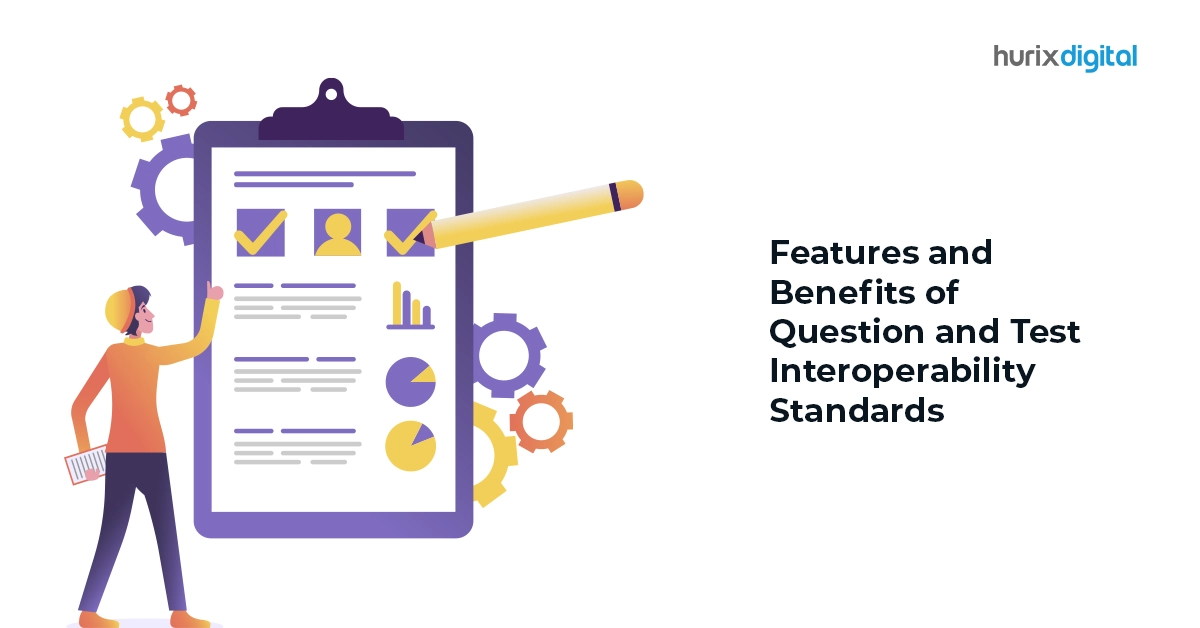
Features and Benefits of Question and Test Interoperability Standards
Summarize with:
For educators navigating the rapidly evolving educational technology landscape, the Question and Test Interoperability (QTI) specification stands out as a crucial standard. It helps achieve interoperability in assessment tools, promoting a more efficient, adaptable, and accessible educational environment.
Developing a better understanding of QTI, how to use it efficiently, and tapping into valuable resources allows educators to navigate the educational landscape effectively. This ensures a more streamlined and consistent online experience for both students and instructors.
In this post, we will learn more about QTI standards and where to use them, along with outlining their key advantages for both students and educators.
Table of Contents:
- What is Question and Test Interoperability?
- Where to Use Question and Test Interoperability?
- Benefits of Question and Test Interoperability
- In Summary
What is Question and Test Interoperability?
QTI refers to a specific set of standards specifically designed to efficiently manage the transfer or movement of files for exam or test questions in student assessments.
A specification managed by the IMS Global Learning Consortium, QTI facilitates the easy and convenient transfer of questions between systems or software. It includes test assembly, item banking, eLearning, training, and so on.
Put simply, the QTI format helps you define a standard format for the easy exchange of assessment content between different learning platforms, such as various LMSs, item banks, and assessment platforms. The data model defines the structure of test questions, assessments as well as exam results using XML data binding.
Also Read: Top 5 Must-Have Features in Automatic Test Generator Software
Where to Use Question and Test Interoperability?
The key focus of the QTI standard is on assessment creation, delivery, and results. The standard is designed to help develop and maintain a comprehensive assessment ecosystem in which there is a seamless movement of the item type and test result data across content authoring tools, LMSs, and other test delivery software.
Question and Test Interoperability also allows educators to ensure that assessments reflect daily instruction or individual subject mastery better.
Apart from this, here is how you can use QTI:
1. Assessments Import/Export
Educators and most educational institutions often use multiple learning management systems and other assessment tools. QTI standards can help simplify the overall process of moving these assessments between various platforms. This eliminates the need for manual adjustments and minimizes the risk of data corruption.
2. Creating Assessments
QTI standards allow educators and institutions to create their test questions or assessments in a fixed or standard format that makes their transfer simple between different learning management systems or platforms. When authoring or creating these assessments, users need to follow all the given specifications. It ensures better compatibility and higher consistency across assessments.
3. Following QTI Specifications
To get the maximum out of the QTI authoring tool, users need to follow the required or given specifications when creating and authoring assessments. Developing a better understanding of the QTI standards and guidelines is important to make sure that the assessments you create are interoperable across different software or learning management systems.
Benefits of Question and Test Interoperability
There are several advantages of using QTI standards for educators. Some of these benefits are discussed below:
1. Higher Efficiency
One of the advantages of QTI is the elimination of the lengthy process of manually transferring data or assessment content between different systems. This helps educators save a great deal of time and also helps maintain the credibility of the assessments.
2. Data Standardization
Another advantage of QTI is the standardization of various data formats within assessments, which ensures that the assessment results are consistent throughout. This standardization of data format helps ensure a smoother exchange of information and also enables educators to gain deeper insights into learner performance across different assessments.
3. Easy Interoperability
QTI standards allow educators to create or author assessments on one learning management system or platform and effortlessly move them to another. This kind of easy software compatibility helps educational institutions navigate the assessment creation process better.
4. Adaptable to Diverse Assessment Types
One of the other significant advantages of QTI standards is that they support multiple types of question formats, including MCQs or multiple-choice questions, short answers, true/false, and more. This adaptability to diverse question types helps teachers come up with engaging yet relevant assessments catering to the different learning styles of individual learners.
5. Enables Powerful Data Analytics
Yet another advantage of the QTI LMS is that it facilitates the recording of deeper and more actionable insights and data. This, in turn, enables teachers to offer students personalized learning experiences based on their performance and achievement of their learning outcomes.
It is also important to note here that while QTI can easily capture data from individual items, it can also capture data across classes, schools, states, and so on. This data then helps them contribute to changes in curriculums that benefit both students and teachers.
6. Virtual Assessments
QTI compliance is a great way of creating assessments as it allows educators to make an easy switch from time-consuming, paper-based tests to more accessible digital or paperless assessments.
Adhering to QTI compliance for assessments can help you save time, money, and resources. It can also help educators derive actionable insights and data so that they can ensure customized learning experiences for students and achieve better learning outcomes in the long run.
Also Read: How Assessment Tools Can Transform Your Hiring Process?
In Summary
Question and test interoperability standards offer educators a well-defined and structured system for authoring assessments. This makes it easier to share these assessments across platforms, systems, and institutions.
QTI 3.0 is the most recent version of QTI standards, offering a range of exciting features to further enhance its capabilities since its previous iteration while also improving access to assessments.
Dictera by Hurix Digital offers an excellent solution for educators and institutions looking for powerful assessment creation or publishing tools that follow the highest QTI standards. The automated QTI validator tool is designed to help teachers and educational institutes create high-quality assessments, collaborate in real time, and gain data-driven insights on student performance.
Connect with us now to learn more about Dictera.
Summarize with:

 We’re live! Explore the all-new
We’re live! Explore the all-new 

